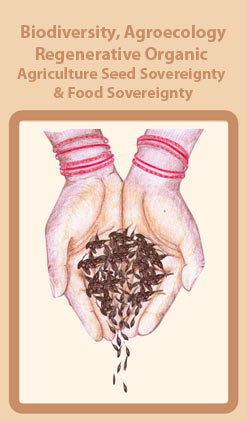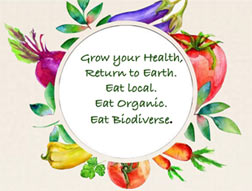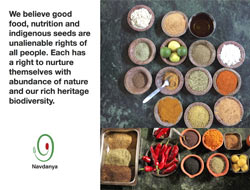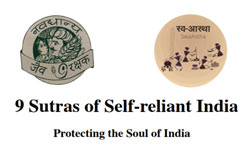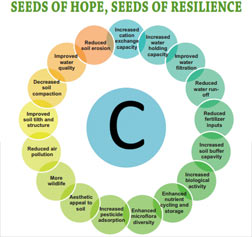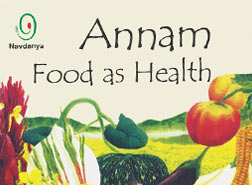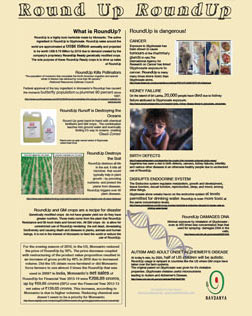Part 1:
WITH GMO LABELS STILL MISSING, LOOK FOR THE OPPOSITE
The White House is 313 miles from my Brooklyn neighborhood, but in early October, 50 or so people set off walking there, as part of the Right2Know campaign. Along the way they were joined by hundreds of others, and rallying in Washington, D.C., Oct. 16, they called on regulators to insist that genetically modified or engineered foods/organisms (known as GEs, or GMOs) be labeled as such, and for President Obama to keep his 2007 campaign promise to do this.
The effort felt in line with the Occupy movement — with the voicing of frustrations that even in simple, common sense ways there seems to be a system working against the majority of us (even back in a 2001 ABC News poll, 93% of people said they wanted GE food labeling). But it was also just one more effort in a decades-long fight — Ohio Rep. Dennis Kucinich has introduced a Genetically Engineered Food Right to Know Act in 1999, 2002, 2003, 2006, 2008 and 2010 — and as far as I can tell the latest effort to fail to get the job done.
There’s a lot of debate about whether or not it’s safe to eat GM foods, but what’s being argued for is simply that they be labeled. We’re living in a time where it’s illegal not to tell consumers if a product is made in a room where nuts are handled, but food can be tinkered with at the DNA level and no one is obligated to say so.
“The denial of food labeling is linked directly to a food dictatorship by Monsanto Corporation,” Vandana Shiva, an activist and the Right2Know keynote speaker said in a statement, voicing a common opinion.
Monsanto, a biotech company whose products have included saccharin, Agent Orange, DDT, nuclear weapons, aspartame and Roundup weed killer, controls the majority of the world’s seeds and reportedly 90% of the world’s GM crops. It alters its seeds so that fields can be sprayed with its Roundup herbicide, killing weeds and bugs but leaving the farmer’s crop standing. The vast majority of corn, soy beans, milk, canola and cotton for cotton seed oil are now GM, and it’s estimated that 75% to 80% of foods in grocery stores are currently GM as a result.
Monsanto’s business methods have been lengthily discussed (“The World According to Monsanto” documentary offers a deep dive for anyone wanting more information), as has the so-called “revolving door” between Monsanto and government agencies. In July, for example, President Obama appointed Michael Taylor, formerly Monsanto’s vice president for public policy, to be deputy commissioner for foods at the FDA.
It can all seem a rather terrifying mess that makes me feel, by turns, depressed and irate. But anyone wanting to avoid GM foods is not wholly without options.
Since my conversation with the director and writer Tamra Davis, I’ve been thinking about her approach to bettering her kids’ school lunches. Finding the red tape around the school program impenetrable, she realized that if she couldn’t change the school, she could instead work to change the kids, educating them so they can make better choices for themselves.
Likewise, until companies are required to label GM foods, we can be savvier and more insistent about our food choices. There are increasing numbers of companies that are happy to announce that they don’t use GM ingredients, and foods with the USDA Organic seal are prohibited from using genetic engineering.
The Center for Food Safety also offers a downloadable True Food Shopper’s Guide (pdf) that lists, by food category, brands that don’t use GMOs and those that may contain them, and includes tips for avoiding modified ingredients. There are also iPhone and Android apps of Guide, for easy consulting while shopping.
Making an effort to choose non-GMO foods isn’t always the most convenient or easy or inexpensive choice, but at least it is a choice. And when it comes to deciding what I put in my body and feed my small daughter, I want to be the one making it.
Part 2:
DENNIS KUCINICH: ALLOW CONSUMERS TO MAKE INFORMED CHOICES
Congressman Dennis Kucinich (D-OH) today issued the following statement upon announcing legislation that would require the labeling of all foods that contain or are produced with genetically engineered (GE) material.
“Genetic engineers have dramatically altered the food we consume, disrupting entire ecosystems and contaminating crops with potentially devastating effects on our long-term health. Despite mounting evidence of the irreversible changes caused by genetic modification, the agribusiness and pharmaceutical industries ask us to believe that experimenting with Mother Nature causes no harm. Already there is ample evidence that this kind of manipulation does have an impact on our bodies and on the ecosystem we all depend on. We cannot rely on the Food and Drug Administration or the U.S. Department of Agriculture to protect us from the threat of GE organisms when those same agencies allowed genetically engineered organisms into our food and pharmaceutical supplies without first requiring objective studies to show they were safe.
“Since GE crops were first approved, the concerns about their very real threat to farmers have become widespread and the questions about the safety of eating GE organisms have steadily grown. Meanwhile the industry has resisted objective study of the issue. To this day, biotechnology companies are largely allowed to self-regulate. Enough is enough. The American people are demanding a right to know. My legislation puts the onus on Congress to be responsive to the will of the people. It gives the power to consumers to make an informed choice about the products they consume.
“Big agribusiness fought efforts to inform consumers about the basic truths of their products. GE crops now cover 10% of global farmland. Now, biotechnology companies heralding a false solution to world hunger want to slip onto supermarket shelves a genetically modified salmon engineered to grow to twice the size of a normal salmon. My common sense legislation will finally allow informed consumers to make their own decisions and to vote with their wallets. People have a right to know how their food is made and whether or not it has been genetically modified,” Kucinich said.
H.R. 3553, The Genetically Engineered Food Right to Know Act, would for the first time, require genetically modified food to be clearly labeled. It would also require the Food and Drug Administration (FDA) to periodically test products to ensure compliance.
Kucinich introduced The GE Food Right to Know Act as part comprehensive regulatory framework for all Genetically Engineered (GE) plants, animals, bacteria, and other organisms, including fish.


